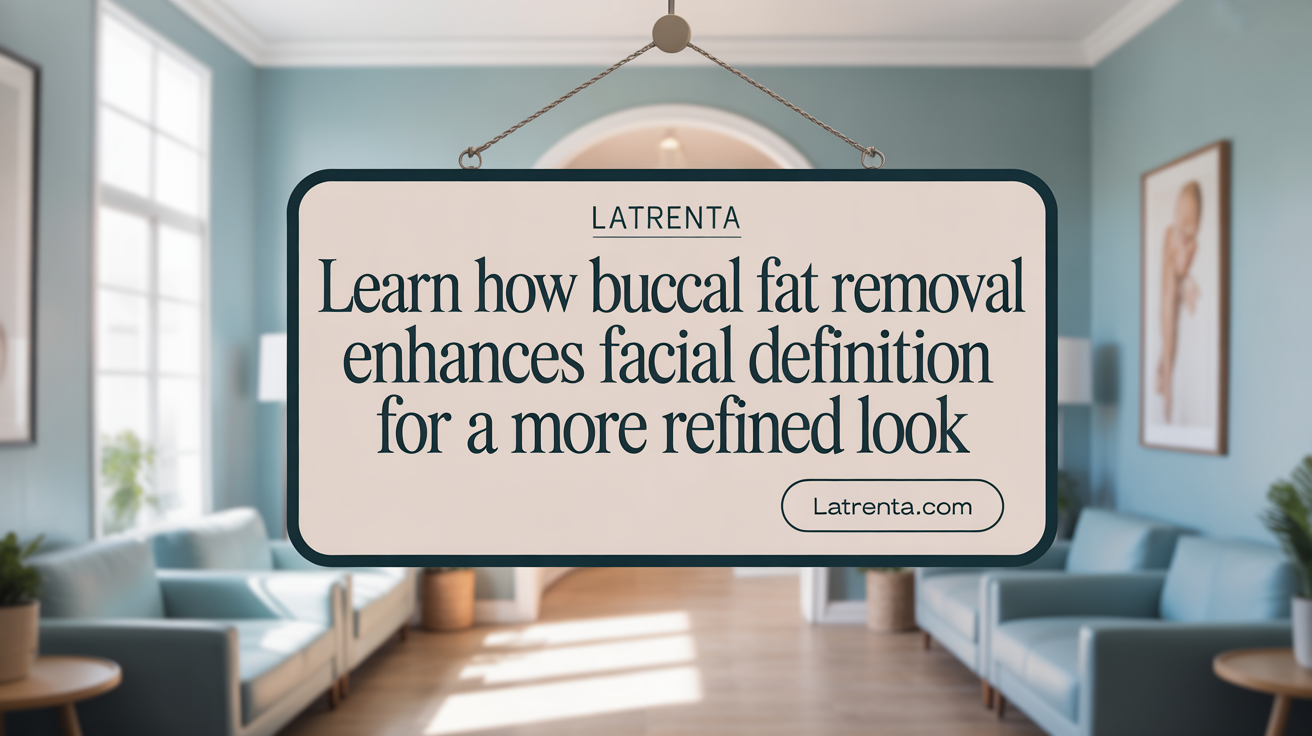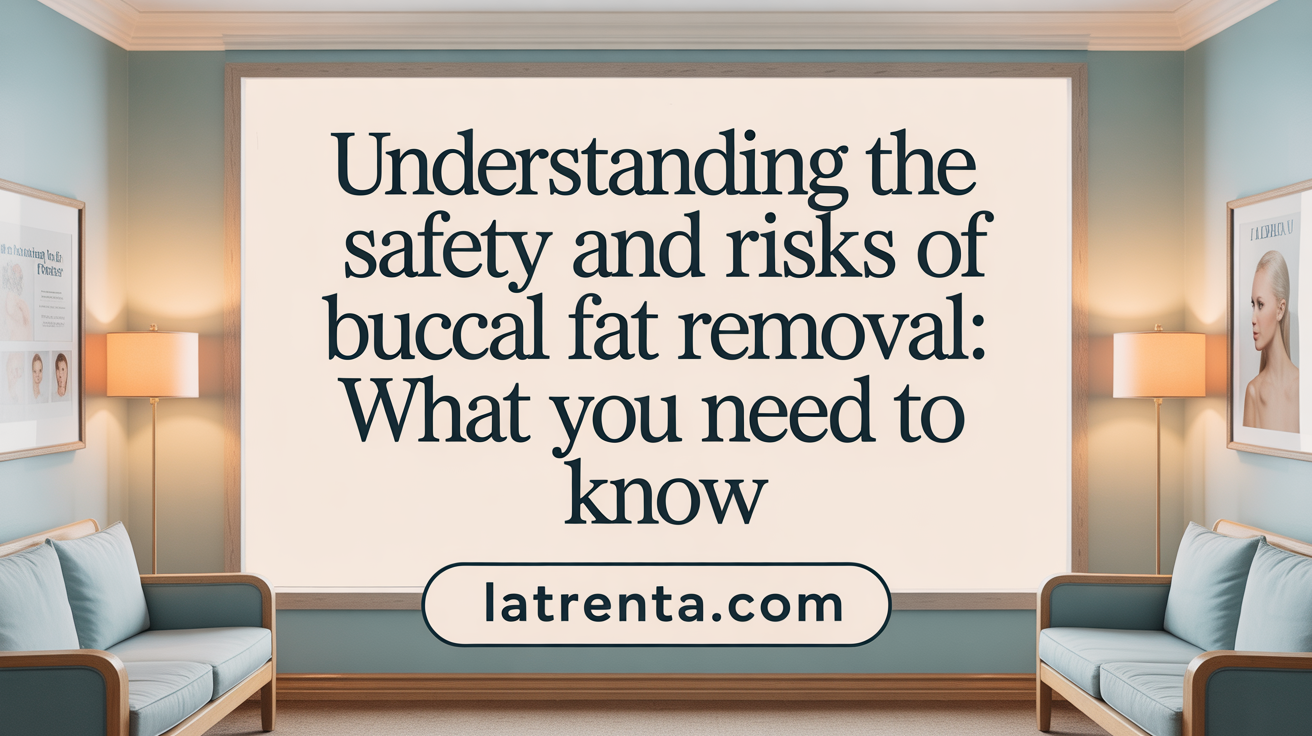Unlocking the Secrets of Facial Contouring
Buccal fat removal has surged in popularity as an effective technique for achieving a slimmer, more defined facial contour. This comprehensive guide explores the procedure’s fundamentals, benefits, risks, recovery, and how it fits within the spectrum of facial sculpting options — empowering readers to make informed decisions about their aesthetic goals.
Understanding Buccal Fat Removal: The Procedure and Its Role in Facial Sculpting

What is the procedure for buccal fat removal and how does it contribute to facial sculpting?
Buccal fat removal, also called buccal lipectomy, is a surgical procedure designed to slim and contour the face by removing excess fat pads located deep within the cheeks. The technique involves making small incisions inside the mouth, usually near the back of the cheek, avoiding visible external scars. Through these tiny cuts, a surgeon accesses the buccal fat pads—natural fat deposits that contribute to facial fullness.
The removal of these fat pads makes the cheekbones more prominent and creates a V-shaped, more sculpted appearance. It helps reduce a rounded, chubby face, revealing sharper cheekbones and a defined jawline. The entire operation typically lasts about 45 minutes to an hour and is performed under local anesthesia, sometimes with sedation or general anesthesia depending on the patient and surgeon's preference.
Most patients experience a smooth recovery period of about three weeks, where swelling and bruising are common but gradually decrease. The final, more contoured look becomes visible after several months once swelling subsides completely.
By removing the buccal fat, the procedure enhances facial symmetry and balance, providing a youthful, streamlined profile. It is especially popular among those with genetic predispositions to full cheeks or those wishing to prevent jowl formation later in life. The results are considered permanent, as the fat does not regrow, but maintaining a stable weight is essential to sustain the outcomes. Overall, buccal fat removal is a straightforward yet transformative procedure that helps define facial contours and restore facial harmony.
Benefits and Aesthetic Outcomes of Buccal Fat Removal

What are the benefits and expected aesthetic outcomes of buccal fat removal?
Buccal fat removal is favored for its ability to significantly enhance facial contours. One of its primary benefits is the clear definition it brings to the cheekbones, resulting in a more sculpted and structured midface.
Patients often seek this procedure to achieve a slimmer, more contoured face, which can provide a more youthful and balanced appearance. By reducing volume in the cheeks, the face appears more refined, with a noticeable decrease in roundness or fullness.
Another advantage is the permanency of the results. Since the excess fat pads are surgically removed and do not regrow, the changes in facial shape tend to last a lifetime. This provides a lasting boost to overall facial aesthetics.
The procedure is minimally invasive, typically involves internal incisions within the mouth, meaning there are no external scars. Recovery is generally quick, with most swelling subsiding within a week, and patients can return to daily activities shortly after.
Overall, buccal fat removal offers a combination of natural-looking enhancement and long-term benefits. It not only improves facial symmetry but also elevates self-confidence by creating a more attractive and harmonious profile.
Risks, Safety Considerations, and Potential Complications

What are the risks, potential complications, and safety considerations associated with buccal fat removal?
Buccal fat removal is generally considered a safe cosmetic procedure when performed by qualified surgeons, but like any surgery, it involves certain risks. Patients must be aware of potential complications to make an informed decision.
One of the most common concerns involves infection, bleeding, and swelling. Post-operative swelling and bruising are normal and usually subside within a few weeks. However, infection, although rare, can develop if proper hygiene and care are not maintained.
Nerve injury is another consideration, particularly since the procedure involves manipulating areas close to facial nerves. Damage to facial nerves can lead to numbness, tingling, or, in rare cases, facial weakness. Additionally, there is a risk of injury to the parotid salivary duct or salivary glands, which can cause salivary issues if affected.
Asymmetry and changes in sensation, such as persistent numbness or uneven facial contours, are potential but infrequent risks. Over-removal of buccal fat can lead to a gaunt or aged appearance, which highlights the importance of conservative fat removal.
Ensuring safety relies heavily on choosing a highly experienced, board-certified plastic surgeon. Such specialists are skilled in precise incision placement and tissue handling, reducing the likelihood of nerve or tissue damage.
Proper preoperative evaluation and post-operative care are vital components of safety. Patients should follow all surgeon's instructions regarding medication, activity restrictions, and follow-up visits.
In essence, while serious complications are uncommon, the importance of professional surgical expertise cannot be overstated for achieving safe and satisfying results.
Ideal Candidate Profile and Timing for Buccal Fat Removal

Who is an ideal candidate for buccal fat removal and what is the recommended age range for this procedure?
An ideal candidate for buccal fat removal is an adult with fully developed facial features, typically between the ages of 20 and 40 years. Candidates usually exhibit full or chipmunk cheeks caused by excess fat in the midface, which doesn’t respond to diet or exercise. These individuals are in good overall health, maintain a stable weight, and have realistic expectations for enhancing their facial contours with subtle, natural results.
Facial development is considered complete around late teens, which is why most surgeons advise waiting until at least 18-20 years old before undergoing the procedure. Performing the operation too early can interfere with natural facial growth and lead to undesirable outcomes. Conversely, for those over 50, natural facial aging—such as volume loss—may render buccal fat removal unnecessary or even detrimental, potentially resulting in a gaunt or aged appearance.
Deciding the right timing depends on individual facial structure, aging trajectory, and aesthetic goals. Since the fat removal is permanent and the cheeks do not regenerate fat, careful assessment by a qualified surgeon is essential to ensure optimal results and prevent premature aging or excessive hollowing of the face.
Recovery Process and Post-Procedure Care

What is the typical recovery process and healing timeline after buccal fat removal? Are there tips for optimal post-procedure care?
The recovery journey following buccal fat removal generally begins with a few days of swelling, bruising, and mild discomfort. These symptoms tend to peak within the first 48-72 hours post-surgery. Most patients notice significant reduction in swelling and discomfort within 1 to 2 weeks, allowing them to resume daily activities and work.
Full healing, including internal tissue settling and final results, usually takes between three to six months. During this period, swelling continues to diminish, and the cheeks gradually contour into their new shape. The gradual reduction of swelling and the healing process can extend up to several months.
To help facilitate a smooth recovery, patients should follow specific care tips. Applying cold compresses during the first 48 hours helps reduce swelling and numbness. Maintaining a soft diet, avoiding hard or crunchy foods, prevents pressure on the surgical area. It’s essential to avoid pressing or massaging the cheeks and to abstain from strenuous activities or heavy lifting for at least a week.
Good oral hygiene is crucial; gentle brushing and using prescribed antiseptic mouthwashes help prevent infection. Regular follow-up appointments allow the surgeon to monitor healing progress and address any complications promptly.
Overall, adhering to the surgeon’s post-operative instructions and caring for the surgical site optimally can enhance recovery outcomes and ensure patient satisfaction with their sculpted facial appearance.
Cost Factors and Financial Considerations
The overall cost of buccal fat removal typically ranges from $2,000 to $5,000. Several elements influence this price, making it important for prospective patients to understand what contributes to the final fee.
One major factor is the geographic location of the surgical practice. Clinics in larger cities or regions with higher demand for cosmetic procedures often have higher prices due to increased operating costs and regional market standards.
Surgeon expertise and reputation also play a significant role. Experienced, board-certified plastic surgeons tend to charge more, reflecting their skill level and the quality of care provided.
Additional expenses beyond the surgeon’s fee include anesthesia, which can be local or general, and facility costs such as operating room charges. Other costs might include preoperative tests, medications, and post-surgery care supplies.
Patients choosing to combine buccal fat removal with other procedures—like chin liposuction, jawline sculpting, or facial fillers—may face higher overall costs, but sometimes benefit from package pricing.
Many clinics offer financing options to make the procedure more accessible. These can include in-house financing plans, third-party credit providers such as CareCredit, and installment arrangements through credit cards.
Understanding these factors helps patients budget appropriately and choose options that best fit their needs without compromising safety or quality.
Comparing Buccal Fat Removal to Other Facial Contouring Techniques
How does buccal fat removal compare to other facial contouring options?
Buccal fat removal is a surgical procedure specifically designed to reduce fullness in the cheeks by removing fat pads from inside the mouth. This targeted approach results in a more sculpted, angular facial appearance with minimal visible scars and a recovery period of about one to three weeks.
In contrast, facial liposuction can address larger areas such as the neck and jawline. It involves suctioning fat from multiple regions and typically requires a longer recovery with more swelling and bruising. Liposuction is more invasive but offers broader shaping options.
Non-surgical options like dermal fillers and Kybella are less invasive. Fillers contour areas by adding volume and can immediately improve aesthetic appearance, but their results are temporary, lasting from six months up to two years. Kybella, an injectable fat dissolver, targets small fat pockets but may require multiple sessions and may not produce as dramatic a slimming effect as surgical removal.
Facelift surgery is more extensive, addressing sagging skin, wrinkles, and laxity for a comprehensive rejuvenation, but involves longer downtime, anesthesia, and higher costs.
Advantages of buccal fat removal’s permanence
One notable benefit of buccal fat removal is the permanence of results. Since the fat pads are excised, they do not regrow, making it a lasting solution for those with genetic cheek fullness. It's especially advantageous for individuals seeking consistent, long-term facial shaping.
Suitability based on aesthetic goals
Choosing between buccal fat removal and alternative procedures depends on specific aesthetic aims. Those wanting a subtle, natural-looking cushion reduction prefer the precision of buccal lipectomy. Patients seeking rapid volume addition or correction of sagging may opt for fillers or a facelift. Considering these differences helps tailor the best approach for individual facial features and desired outcomes.
Combining Buccal Fat Removal with Other Procedures for Enhanced Results
Many patients interested in buccal fat removal opt to enhance their facial contours further by combining it with other cosmetic procedures. This integrated approach aims at achieving a more balanced, harmonious, and youthful appearance.
Common procedures to combine with buccal fat removal include:
| Procedure | Purpose | Additional Benefits |
|---|---|---|
| Chin implants | Improve chin projection and overall facial balance | Enhances jawline definition, complements cheek slimming |
| Jawline sculpting | Define or reshape the jawline | Creates a more angular, contoured lower face |
| Rhinoplasty | Reshape the nose | Improves facial harmony and proportion |
| Facelift | Tighten loose skin and reduce sagging | Restores youthful contours, especially in older patients |
| Morpheus8 | Skin tightening and collagen boosting | Reduces wrinkles, improves skin texture |
| Radiesse volumizing | Adds volume to cheeks and other areas | Restores facial fullness while maintaining natural look |
Benefits of combining treatments:
- Achieving a comprehensive facial transformation
- Customizing the aesthetic outcome to personal goals
- Reducing total recovery time by combining procedures
- Enhancing facial symmetry and contour in a single surgical session
Adopting a holistic approach to facial rejuvenation ensures that all aspects—from bone structure to skin quality—are addressed. It results in a natural, balanced appearance that can significantly boost confidence.
Consultation and planning with an experienced facial plastic surgeon are crucial to determine the most suitable combination of procedures. This ensures safe, effective results aligned with the patient’s desires and physical characteristics.
While combining treatments offers great benefits, it’s essential to understand that each additional procedure may add to the overall recovery process, so proper planning and realistic expectations are vital.
Making an Informed Choice in Facial Sculpting
Buccal fat removal offers a precise, lasting way to enhance facial contours and achieve a youthful, sculpted appearance. Understanding the procedure, benefits, risks, candidate suitability, recovery, and cost is essential for anyone considering this transformation. Paired with complementary treatments, it can provide balanced and natural-looking facial rejuvenation. Consulting with a qualified, experienced surgeon ensures personalized care tailored to individual goals. With informed decisions and proper care, patients can confidently embrace the benefits of buccal fat removal and facial sculpting to reveal their best selves.
References
- Buccal Fat Removal | Johns Hopkins Medicine
- The Expert Guide to Buccal Fat Removal Surgery
- Buccal Fat Removal: Your Guide to Recovery & Results
- Buccal Fat Pad Surgery 101 | Babak Azizzadeh
- How To Lose Face Fat: A Guide To Facial Sculpting - Saxon MD
- The Ultimate Guide To Buccal Facial: Lift & Sculpt Naturally
- Buccal Fat Removal vs. Facial Fillers Read More - Park Aesthetics
- Maximizing Beauty: Top Benefits of Combining Buccal Fat Removal ...
- Chin Liposuction and Buccal Fat Removal Procedures for Facial ...
